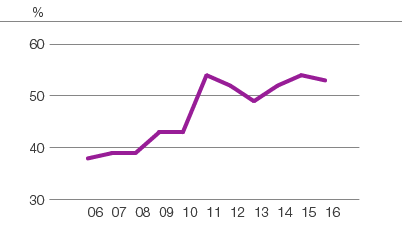Biofuels
Developing and producing biofuels is both an efficient use of resources and beneficial for a low-carbon economy.
Results 2016
Use of biofuel, 2006–2016

SCA is working systematically to replace oil and coal with biofuel and natural gas, which has substantially increased biofuel’s share of the energy supply.
In 2016, SCA produced approximately 2.85 TWh (2.69, 2.75) of biofuel-based energy, of which the production of forest-based biofuels accounted for approximately 740 GWh (610, 687). The market situation, with a plentiful supply of competing fuels and low energy prices, held back deliveries.
The forest-based biofuels comprise felling residue such as branches, tops and stumps as well as fuel from peatland. Other biofuels are produced from the by-products of the mills, mainly sawdust, for pellet production.
Fuel pellets
SCA produces fuel pellets at its pellet plants in Härnösand and Stugun in Sweden using sawdust from its own mills. SCA sources electricity for the two pellet plants from its Björkhöjden wind farm. In 2016, SCA produced 231,000 tons of pellets of which 53% was sold to customers outside the Group. Fuel pellets are used in boilers of varying sizes, ranging from industrial scale to those used in private homes. The market is currently characterized by narrow margins due to overcapacity. As a result of this situation, SCA is focusing on improving quality and increasing the internal use of pellets as a substitute for fossil fuels. SCA BioNorr also produces stall bedding pellets manufactured from sawdust.
